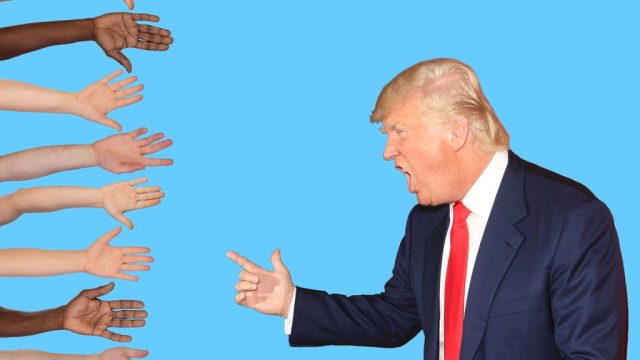The 5 Handshake Rules That Trump Breaks Every Time

No one will argue with you for accusing President Trump of having an overabundance of personal quirks. For starters, the guy’s an avowed “germaphobe” who barely sleeps and has a peculiarly outsize love of meat loaf. He also uses hairspray. And for a man really, really sensitive about his hands, he’s got perhaps the strangest handshake in the history of the Oval Office.
As countless videos and news articles have shown, Trump’s signature handshake unfolds like this: first, a long extension of the arm; second, an iron-strong grip; third, a jarring yank of the person toward him, as if he were pull-starting a lawnmower; and finally, of course, there’s the awkwardly long and animated shake. When Trump met with Japanese Prime Minister Shinzo Abe earlier this month, he proceeded to shake his hand for 19 painful seconds, gripping and patting as the Japanese leader clearly struggled to escape. Here’s a terrific example of the “Trump Shake” at work on Supreme Court nominee Neil Gorsuch:
Psychologists have argued that Trump’s handshake is nothing short of psychological warfare, an opening salvo meant to put others at a disadvantage. “He knows that images of these greetings will be shown around the world,” writes The Sydney Morning Herald, “and that they will make it look as if he is the man in charge.”
If that’s true, other leaders are onto him. Last week, it was clear that the youthful Canadian Prime Minister Justin Trudeau had studied Trump’s handshake very closely. When he met him at the White House, the lithe Trudeau clearly out-foxed the president by bounding out of his limo and closing in on him faster than Luke Kuechly on an unsuspecting running back. He escaped the “yank” altogether and successfully withdrew his hand before finding himself locked in Trump’s deathgrip.
President Trump welcomes Canadian Prime Minister Justin Trudeau to the White House. https://t.co/n7TqA3VDnW pic.twitter.com/5TcpyDfZx5
— ABC News (@ABC) February 13, 2017
It all got us thinking: what exactly is the etiquette for a proper handshake between two consenting adults? And should anyone ever try President Trump’s extension-and-pull? We spoke to one expert, and the short answer is: no. If you’re a non-billionaire working to build relationships and grow a business, you’d be better off wielding a handshake that is a gesture of friendship and goodwill, and not necessarily used to intimidate any future partners.
That said, here are the five handshake rules that President Trump happily breaks—and how you can do it right. And once you’ve nailed the perfect handshake, don’t miss the 25 Ways the Smartest Men Get Ahead at Work.
RULE 1: Always Stand Up

“It is not good manners to shake hands sitting down,” says William Hanson, a top etiquette coach who has provided training to companies including Barclays, Hilton, and Bentley.
A handshake should take place with both individuals standing, which gives the exchange a greater sense of formality and respect. Sitting comes off as casual, though Hanson acknowledges that this is “a faux pas many heads of state make at such photo-calls (including President Trump and his predecessor).”
RULE 2: Get the Angle Right

When shaking a hand, you should put your palm facing inward—not downward, or upward as Trump does with Japanese Prime Minister Shinzo Abe. Putting your hand on top of another person’s “is bad practice, as body language experts will say this shows you wish to dominate the other person,” says Hanson.
RULE 3: Keep Your Left Hand at Your Side

That game of dominance seems to be what’s going on with the Shinzo Abe handshake—but with a twist. The President offers his hand to the Japanese PM palm facing up, seemingly taking the submissive position. But then Trump reverses the roles by bringing his left hand in to pat Abe’s hand, in a signal that may seem like meant at comforting the foreign leader, but more often (particularly when used by the President) a gesture of dominance. It’s a move similar to another that Hanson sees often and urges men to cut out of their repertoire.
“The back slap! I hate it,” he says. “Use just your right hand when shaking hands. Your left hand remains by your side—not slapping my back and not placing it over our right hands as we shake.”
An exception may be as a counter to a handshake like Trump’s. A quick backslap, as Trudeau executed in their standing handshake, can be an effective way to politely push back and avoid being pulled in and controlled by someone more aggressive.
RULE 4: Adjust the Pressure

“A handshake should be firm, but not too firm,” says Hanson. “It’s a compromise and obviously the strength you use will vary depending on the person you are greeting. You will be firmer for a sportsman than you would be for the elderly, for example.” For more great guy rules, here’s Why Real Men Carry Cash.
RULE 5: Don’t Overstay Your Welcome

Perhaps the biggest lesson to take away from the infamous shake: Know when to hold—and know when to let go. “In the U.K. and America it is usually two pumps when shaking,” says Hanson, “but in other cultures—like China—it can be several more.”
Perhaps Trump thought that longer handshakes are preferred in Japanese culture as well. But no culture shakes hands for 19 seconds, as Hanson explains: “The handshake goes on far too long, even by some Asian standards of length of handshake. Too long and too awkward.” If you really want to boost your office etiquette, take our quiz to know whether or not you’re a terrible boss.
For more amazing advice for living smarter, looking better, feeling younger, and playing harder, sign up for our newsletter—delivered every day!